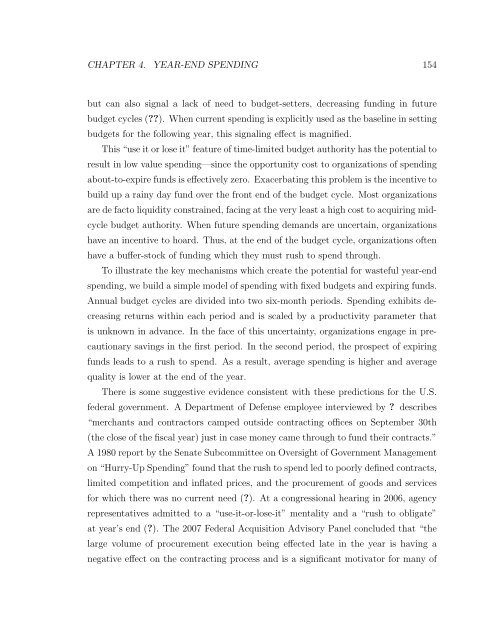essays in public finance and industrial organization a dissertation ...
essays in public finance and industrial organization a dissertation ...
essays in public finance and industrial organization a dissertation ...
Create successful ePaper yourself
Turn your PDF publications into a flip-book with our unique Google optimized e-Paper software.
CHAPTER 4. YEAR-END SPENDING 154<br />
but can also signal a lack of need to budget-setters, decreas<strong>in</strong>g fund<strong>in</strong>g <strong>in</strong> future<br />
budget cycles (??). When current spend<strong>in</strong>g is explicitly used as the basel<strong>in</strong>e <strong>in</strong> sett<strong>in</strong>g<br />
budgets for the follow<strong>in</strong>g year, this signal<strong>in</strong>g effect is magnified.<br />
This “use it or lose it” feature of time-limited budget authority has the potential to<br />
result <strong>in</strong> low value spend<strong>in</strong>g—s<strong>in</strong>ce the opportunity cost to <strong>organization</strong>s of spend<strong>in</strong>g<br />
about-to-expire funds is effectively zero. Exacerbat<strong>in</strong>g this problem is the <strong>in</strong>centive to<br />
build up a ra<strong>in</strong>y day fund over the front end of the budget cycle. Most <strong>organization</strong>s<br />
are de facto liquidity constra<strong>in</strong>ed, fac<strong>in</strong>g at the very least a high cost to acquir<strong>in</strong>g mid-<br />
cycle budget authority. When future spend<strong>in</strong>g dem<strong>and</strong>s are uncerta<strong>in</strong>, <strong>organization</strong>s<br />
have an <strong>in</strong>centive to hoard. Thus, at the end of the budget cycle, <strong>organization</strong>s often<br />
have a buffer-stock of fund<strong>in</strong>g which they must rush to spend through.<br />
To illustrate the key mechanisms which create the potential for wasteful year-end<br />
spend<strong>in</strong>g, we build a simple model of spend<strong>in</strong>g with fixed budgets <strong>and</strong> expir<strong>in</strong>g funds.<br />
Annual budget cycles are divided <strong>in</strong>to two six-month periods. Spend<strong>in</strong>g exhibits de-<br />
creas<strong>in</strong>g returns with<strong>in</strong> each period <strong>and</strong> is scaled by a productivity parameter that<br />
is unknown <strong>in</strong> advance. In the face of this uncerta<strong>in</strong>ty, <strong>organization</strong>s engage <strong>in</strong> pre-<br />
cautionary sav<strong>in</strong>gs <strong>in</strong> the first period. In the second period, the prospect of expir<strong>in</strong>g<br />
funds leads to a rush to spend. As a result, average spend<strong>in</strong>g is higher <strong>and</strong> average<br />
quality is lower at the end of the year.<br />
There is some suggestive evidence consistent with these predictions for the U.S.<br />
federal government. A Department of Defense employee <strong>in</strong>terviewed by ? describes<br />
“merchants <strong>and</strong> contractors camped outside contract<strong>in</strong>g offices on September 30th<br />
(the close of the fiscal year) just <strong>in</strong> case money came through to fund their contracts.”<br />
A 1980 report by the Senate Subcommittee on Oversight of Government Management<br />
on “Hurry-Up Spend<strong>in</strong>g” found that the rush to spend led to poorly def<strong>in</strong>ed contracts,<br />
limited competition <strong>and</strong> <strong>in</strong>flated prices, <strong>and</strong> the procurement of goods <strong>and</strong> services<br />
for which there was no current need (?). At a congressional hear<strong>in</strong>g <strong>in</strong> 2006, agency<br />
representatives admitted to a “use-it-or-lose-it” mentality <strong>and</strong> a “rush to obligate”<br />
at year’s end (?). The 2007 Federal Acquisition Advisory Panel concluded that “the<br />
large volume of procurement execution be<strong>in</strong>g effected late <strong>in</strong> the year is hav<strong>in</strong>g a<br />
negative effect on the contract<strong>in</strong>g process <strong>and</strong> is a significant motivator for many of










